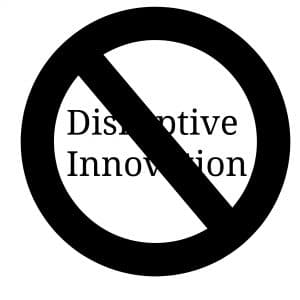Is Competency Education a Disruptive Innovation? The Answer is No
CompetencyWorks Blog
 Once upon a time when Susan Patrick and I were just starting to understand the field of competency education, we described it as a disruptive innovation…until Michael Horn explained why it wasn’t.
Once upon a time when Susan Patrick and I were just starting to understand the field of competency education, we described it as a disruptive innovation…until Michael Horn explained why it wasn’t.
Competency education can be considered an innovation, just not a disruptive one. It may be reaching underserved consumers, but not necessarily with a different value proposition. Competency education isn’t a new product, technology, or service that is introducing new values and benefits to new sets of consumers. It just doesn’t meet the definitions of a disruptive innovation as developed by Clayton Christensen.
But if it isn’t a disruptive innovation, what is it?
I’m not done thinking about this, but wanted to share my thinking to date. The better we get at explaining what competency education is, the better off we will be as a field.
- Competency education is a system of beliefs and assumptions based on research about child development, learning, and motivation: It’s firmly rooted in the growth mindset. It’s based on the understanding that one can’t separate out the habits of learning and social-emotional learning from academic learning. It takes the zone of proximal learning seriously by responding to the fact that children in any grade level are at different points in their learning and that there may be variation in their skills across disciplines. It assumes children will learn differently. (See The Past and the Promise published by JFF for more information.)
- Competency education is a structure designed to ensure students’ needs are being met as well as a structure that enables flexibility in the delivery of educational services. I’ve heard it described as a platform, an infrastructure, or a system. Regardless of the term, competency education is at minimum a school-wide and preferably a district-wide structure that defines the expectations of what will be learned, monitors the progress and pace of students, creates a more timely (and sometimes even just-in-time) response to students, and enables student agency by ensuring transparency. We are just starting to understand what it means to deploy resources more flexibly to ensure students are progressing. What we haven’t looked at yet are the actual economic benefits from timely delivery of resources and creating student agency. It is possible that we are actually seeing a shift of the cost of production to students.
- Competency education is a district or school policy that claims responsibility for helping students reach proficiency – not just recall or comprehension, but a level of proficiency that means students can use what they are learning. No more accepting recall and comprehension as adequate levels of learning. No more passing students on to the next level with Cs and Ds. If schools have systems in place that help them be effective, it’s easy for them to take responsibility for the delivery of services. If the competency-based platform is designed for equity rather than reproducing inequity as the traditional structure does, can’t we take a step back from this top-down accountability system and create a coherent one that builds from the ground up?
- Mostly importantly, competency education is a method of management. Competency education is rooted in the practices of total quality management and continuous improvement. It establishes a closed system where we strive for 100 percent effectiveness (or as Marzano refers to it – high reliability). If you can’t just pass kids on with Cs and Ds, then you are going to have to figure out what has to happen to help them learn all the way to proficiency.
Competency-based has become a very popular term, used frequently by digital content vendors to describe self-paced. (This makes me think that perhaps it is good that it such a awkward phrase otherwise it might be used for each and every product and approach in education). The problem is that many people are cherry-picking the definition of competency education by taking the first element of competency education – advancing upon mastery – without looking at the remaining four elements. Perhaps digital content vendors could use the full definition to improve the quality of their products – making them more transparent, pushing for higher levels of knowledge, focusing more on performance-based outcomes, and designing them to be more helpful for students to reflect upon their learning process.
A final thought — maybe it’s good thing that competency education isn’t a disruptive innovation. I don’t know about you, but my mother gets enraged at the term disruption with morning rants about Uber, the loss of local bookstores, and the impact of digital commerce on our nation’s sense of community and responsibility to each other. Assuming that the ever-increasing use of the term disruptive is also generating a backlash of emotions, perhaps by not being a disruptive technology we are avoiding a communication challenge – especially as we enter the next presidential campaign season.